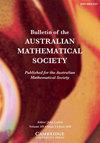ON A CONJECTURE ON SHIFTED PRIMES WITH LARGE PRIME FACTORS, II
IF 0.5
4区 数学
Q3 MATHEMATICS
引用次数: 0
Abstract
Let  $\mathcal {P}$ be the set of primes and
$\mathcal {P}$ be the set of primes and  $\pi (x)$ the number of primes not exceeding x. Let
$\pi (x)$ the number of primes not exceeding x. Let  $P^+(n)$ be the largest prime factor of n, with the convention
$P^+(n)$ be the largest prime factor of n, with the convention  $P^+(1)=1$, and
$P^+(1)=1$, and  $ T_c(x)=\#\{p\le x:p\in \mathcal {P},P^+(p-1)\ge p^c\}. $ Motivated by a conjecture of Chen and Chen [‘On the largest prime factor of shifted primes’, Acta Math. Sin. (Engl. Ser.) 33 (2017), 377–382], we show that for any c with
$ T_c(x)=\#\{p\le x:p\in \mathcal {P},P^+(p-1)\ge p^c\}. $ Motivated by a conjecture of Chen and Chen [‘On the largest prime factor of shifted primes’, Acta Math. Sin. (Engl. Ser.) 33 (2017), 377–382], we show that for any c with  $8/9\le c<1$,
$8/9\le c<1$,  $$ \begin{align*} \limsup_{x\rightarrow\infty}T_c(x)/\pi(x)\le 8(1/c-1), \end{align*} $$
$$ \begin{align*} \limsup_{x\rightarrow\infty}T_c(x)/\pi(x)\le 8(1/c-1), \end{align*} $$
which clearly means that  $$ \begin{align*} \limsup_{x\rightarrow\infty}T_c(x)/\pi(x)\rightarrow 0 \quad \text{as } c\rightarrow 1. \end{align*} $$
$$ \begin{align*} \limsup_{x\rightarrow\infty}T_c(x)/\pi(x)\rightarrow 0 \quad \text{as } c\rightarrow 1. \end{align*} $$
关于大质因数移位素数的猜想,ii
让 $P^+(n)$ 是 n 的最大素因子,约定为 $P^+(1)=1$,并且 $ T_c(x)=\#{p\le x:p\in \mathcal {P},P^+(p-1)\ge p^c\}.$ 由陈和陈的一个猜想激发['论移位素数的最大素因子', Acta Math.Sin.(Engl. Ser.) 33 (2017), 377-382], 我们证明,对于任意具有 $8/9\le c<1$ 的 c,$$ \begin{align*}\limsup_{x\rightarrow\infty}T_c(x)/\pi(x)\le 8(1/c-1), \end{align*}这显然意味着 $$ (开始{align*}\T_c(x)/\pi(x)\rightarrow 0 \quad \text{as } c\rightarrow 1.\end{align*}$$
本文章由计算机程序翻译,如有差异,请以英文原文为准。
求助全文
约1分钟内获得全文
求助全文
来源期刊
CiteScore
1.20
自引率
14.30%
发文量
149
审稿时长
4-8 weeks
期刊介绍:
Bulletin of the Australian Mathematical Society aims at quick publication of original research in all branches of mathematics. Papers are accepted only after peer review but editorial decisions on acceptance or otherwise are taken quickly, normally within a month of receipt of the paper. The Bulletin concentrates on presenting new and interesting results in a clear and attractive way.
Published Bi-monthly
Published for the Australian Mathematical Society

 求助内容:
求助内容: 应助结果提醒方式:
应助结果提醒方式:


